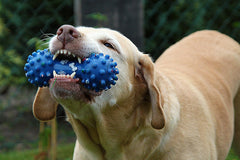
No chauvinism in cynology
Note: Cynology is the study of matters related to canines or domestic dogs. A breed comes from its origin or rather from its homeland, most of the time. It can be the name of a country like the German Shepherd, the English Setter, or the Afghan Hound. It can also be the name of a region like Beauce Shepherd, the Brittany Spaniel, or the Chihuahua. A dog’s breed can even be the name of a city like the Rottweiler, of a large village like the Pont-Audemer Spaniel, or of a town like Groendael. Some people have given their name to a breed such as Mr. Dobermann or the Reverend Jack Russell.
Breeds by Their Color
The designation of a breed by its color falls into disuse: the black and tan Setter has been renamed Gordon. Bas-rouge as a way to designate Beauce Shepherd is no longer used. Lemon Setter for a variety of English Setters that are more tricolor than lemon yellow is no longer used, either. There remain the Fawn of Brittany because it is well known for its fawn color. There is also the Blue of Gascony which is no more blue than the Setter is yellow.
Geographical Origin
It is the geographical origin of the breed which, in addition to the function, designates most of the breeds. However, the geographical origin of the breed is almost never decisive in choice, thus rarely going as far as influencing the behavior of the buyer. No one seems to care. After the First World War, the German adjective wasn’t very pleasant to the ears of the French and their allies. Regardless, the German Shepherd was not banned in France. In fact, it was around that time that it began to overtake the French Shepherds whose livestock were reduced at the end of the First World War. The most popular dog breeds in the world include the German Shepherd. It conquered not only France but the whole world because it was a good breed and the connoisseurs were spot on. Now, in order not to acknowledge German supremacy, French cynology renamed it Shepherd of Alsace after the Great War. The English and the Americans found it to be an excellent idea and called Alsatian the breed that was created in Saxony, far from Alsace, by a native German named Max Von Stefanitz, as they say. The name did not last and failed to completely replace the expression German Shepherd. However, it was not until the Franco-German rapprochement initiated by De Gaulle and Adenauer that the German Shepherd got its name back once and for all. Under the impulse of the SV, it also resumed its expansion, almost a hegemony, deemed unique in the history of cynology. This breed was German, no one disagreed, and rather than reject it out of nationalism, lovers of the breed had renamed it shepherd of Alsace. Is it for the same reason that the German Great Dane became Danish in France and Great Dane in Great Britain? No one knows for sure. The Danes didn’t ask for anything and the Germans didn’t take offense for so little. Some connoisseurs only reminded the historical fact. Another instance of nationalization: the White Shepherd, whose leaders of the German SV wanted nothing to do with, became Swiss. The breed, finally acknowledged, even became prosperous. These are, I believe, the only cases in the history of cynology. Let us nevertheless mention a particular case: the Afghan Hound, which is called Afghan everywhere except in Afghanistan, where it is called Eastern Greyhound or Persian Greyhound. All breed promoters have indeed always bickered over different points of standard, judgments, uses and other, but have quite rarely argued that their country was the holder of said standard. It did happen, though: in the 1980s, Dr. Surget, president of the Belgian Shepherd French Club, insisted on admitting the color sand in the Tervueren, presenting arguments that the Belgians did not want to hear. Many palaver, all forgotten...until the Belgian club put an end to the debates: “Belgium holds the standard. It’s the Belgians who decide. Period. The French had a similar behavior when the Swiss, among others, wanted to abolish the obligation of double lugs in Beauce. They were not lacking in arguments either: the pins are not functional and to impose them translates to eliminating from reproduction subjects without pins but with great morphological or mental qualities. The French kindly reminded the Swiss that they alone had the power to modify the standard, since they were its holders.
Dog Lovers Do Not Care About the Origin of Dogs
That being said, generally speaking, dog loves do not care about the origin of all dogs. The standard of bouvier des flandres was French, Belgian, then Franco-Belgian. Amateurs did not beat themselves up about it. They knew and can still make a fuss, but the nationality of the breed has never been the subject of contention. At the beginning of the 20th century, when the border was still closed, breeders went looking for breeders on one side or the others. Fun fact - some of them smuggled a bit of tobacco with their dogs, whose bravery and endurance were tested. And so the selection is made…
Scots and the English
The Scots and the English never had much affection for each other. On one side of Hadrian’s wall which separates the two nations they had the collie, on the other the ancestral English Shepherd dog became bobtail. On each side, but probably very close to the border, the Shepherds used another breed which has proven to be much superior to others for herd work. Agreeing on its qualities, the English and the Scots didn’t fight for long on the name of the breed when they had it recognized by the Kennel club: Border-Collie. Now, that was an appellation that suited all those who did not have much to do with political quarrels. A happy initiative to get everyone to agree: the Border-Collie is as Scottish as it is English.
Deciding on the Name of the Breeds
By deciding on the name of the breeds, the cinologist therefore claimed their nation, and others did their region or their city. However, these rarely show any gratitude. Does a region honor the breed that bears its name? Which city recalls that a breed made it known? The city of Rottweil erected a statue of the rottweiler at its gates. The town of Callac announces on its signs at the entrance to the town: “Cradle of the Brittany Spaniel”. The Bern Museum dedicates a gallery to Saint Bernard, whose origin is remembered near the glacier at the Col du Petit-Saint-Bernard. That’s about all. Still, it is no wonder Pont-Audemer, a small town of 9,000 inhabitants, did nothing for the Spaniel that bears his name: the breed is not prosperous. But that Mechelen, which owes its fame to the Malinois, does it no honor, is a shortcoming. The city which has more than 80,000 inhabitants, makes more of the cuckoo clock of Mechelen (chicken) and its beer than of the breed of dog who bears his name and who became the first in the world for guard and defense. The reason for this - chicken and beer are products. The dog is not a product, even if it is the subject of a production and in most cases an act of purchase. In any case, the Malinois has not been a product of Mechelen for a long time. With that being said, the tourist office has plans to suggest to the burgmeister and his aldermen to repair this oversight that leaves the cynologist in Mechelen and elsewhere indifferent. Just like the cynophile of Pont-Audemer, Tervuren, Naples, Bordeaux do not ask that these cities remind that breeds bear their name. Why? Because the origin and the name of the breeds are not a subject for those who are interested. Neither the Spaniards nor the Italians or the Russians have successful national breeds. That doesn’t stop them from being great-dog-loving nations with world-class breeders and users. The amateurs - and the professionals too - set their sights on one or more breeds without worrying about the place they are supposedly created in. Patriotism does not interfere in their choices and nationalism is of even smaller impact. Dogs of the world are not chauvinistic. A breed is loved for what it is, for its morphology, its character and most often for both, but not for the name it bears or the place it comes from. Again, everyone has their own taste preferences, but dog lovers have little prejudice and rightly consider that the name given to a breed at a given time is something incidental. Jean-Yves Reguer, originally written in French Jean-Yves is a friend of mine and he was kind enough to share this article with me.
What is the smartest dog breed?
What dog breed lives the longest?
What is the largest dog breed?
Check out our blog and follow me on LinkedIn to stay up-to-date!





Comments
I would like to adopt a yorkie, chihuahua or toy poodle and any that’s mixed